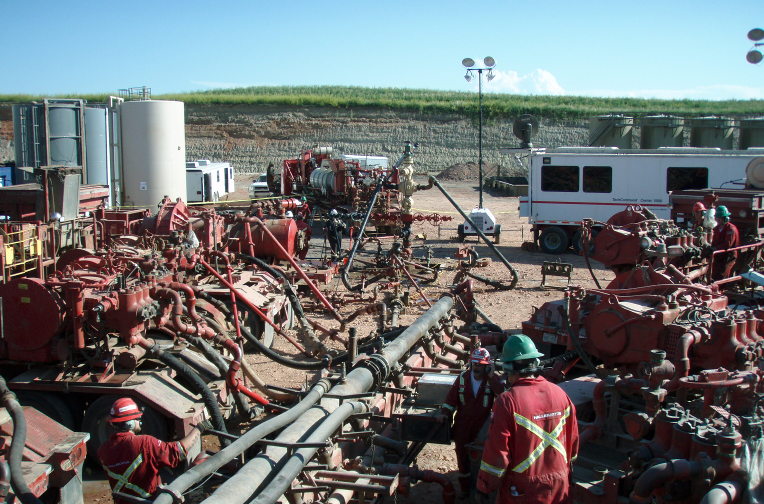When oil drillers descended on North Dakota en masse a decade ago, state officials and residents generally welcomed them with open arms. A new form of hydraulic fracturing, or “fracking” for short, would allow an estimated 3 to 4 billion barrels of so-called shale oil to be extracted from the Bakken Formation, some 2 miles below the surface.
The boom that ensued has now turned to bust as oil prices sagged in 2019 and then went into free fall with the spread of the coronavirus pandemic. The financial fragility of the industry had long been hidden by the willingness of investors to hand over money to drillers in hopes of getting in on the next big energy play. Months before the coronavirus appeared, one former oil CEO calculated that the shale oil and gas industry has destroyed 80 percent of the capital entrusted to it since 2008. Not long after that the capital markets were almost entirely closed to the industry as investor sentiment finally shifted in the wake of financial realities.
The collapse of oil demand in 2020 due to a huge contraction in the world economy associated with the pandemic has increased the pace of bankruptcies. Oil output has also collapsed as the number of new wells needed to keep total production from these short-lived wells from shrinking has declined dramatically as well. Operating rotary rigs in North Dakota plummeted from an average of 48 in August 2019 to just 11 this month.
Oil production in the state has dropped from an all-time high of 1.46 million barrels per day in October 2019 to 850,000 as of June, the latest month for which figures are available. Even one of the most ardent oil industry promoters of shale oil and gas development said earlier this year that North Dakota’s most productive days are over. CEO John Hess of the eponymous Hess Corporation is taking cash flow from his wells in North Dakota and investing it elsewhere.
So, what has this meant for the state? Not only is the oil industry in North Dakota suffering, but all those contractors who service the oil industry. Beyond that are the housing and public services which had to be expanded dramatically during the boom. Will there be enough people to live in that housing years from now? Will the cities be able to maintain the greatly expanded infrastructure their dwindling tax revenues must pay for?
The state government relies on oil and gas revenues for 53 percent of its budget. So far those revenues are running 83 percent lower than projected for this year. In addition, the pandemic reduced other revenue sources, but those are returning to normal as the overall economy bounces back (at least for now). North Dakota’s historically low unemployment rate popped from 2 percent in March to 9.1 percent in April, but has recently come down.
Perhaps the most enduring legacy of the boom will be the damage to the landscape and the water in North Dakota from years of sloppy environmental practices. While companies are legally responsible for cleaning up their sites and capping old wells, in practice the state’s failure to force companies to post bonds to pay for these things means much of the work will have to be done by the state or not done at all. This is because bankrupt companies are just abandoning their wells and other infrastructure. There will be no one left with money to sue to pay for the cleanup in many cases.
What North Dakota may have traded for a temporary boom is a long-lived legacy of tainted land and especially water. Back in 2012 I warned about this danger from the fracking industry in a piece called “Pincushion America: The irretrievable legacy of drilling everywhere on drinking water.”
In that piece, I cited a former EPA engineer who said that within 100 years most of the country’s underground drinking water will be contaminated. What has happened in North Dakota (and is still happening at a somewhat reduced rate) has likely sped up that timetable considerably for the state. Even with the waning oil industry, the state still has considerable oil to produce and so the damage will only continue to mount.
North Dakota may now experience a long, slow withdrawal from what is called the resource curse. This is the paradoxical notion that natural resource-rich jurisdictions often fail to prosper partly due to the huge swings in prices of their principal products, swings which destabilize their societies. This is because disproportionate amounts of wealth (including labor) are devoted to the natural resource sector and therefore unavailable for other more stable forms of commerce and industry.
In addition, the enormous wealth and influence of those in the natural resource sector are used to thwart environmental protections necessary for the long-term well-being of the population. This influence also keeps taxes on the industry low, depriving the people in the state of the full fruits of the resource boom (and of investments necessary for the day when the resource will be depleted).
Beyond this, governments tend to rely on resource sectors too much for their revenue. This causes them to overspend during booms and face austerity during downturns.
All of the negative effects of the resource curse are now on display in North Dakota and may well get worse. Of course, what North Dakota is experiencing, many resource-rich places around the world are also experiencing in one form or another. The worst thing the state can do now is live by the hope that the oil industry will revive and save North Dakota from its woes. Now is the time to plan a new path to a more stable and sustainable economy.
Photo: Fracking the Bakken Formation in North Dakota (2011). Photo by Joshua Doubek via Wikimedia Commons https://commons.wikimedia.org/wiki/File:Frac_job_in_process.JPG






